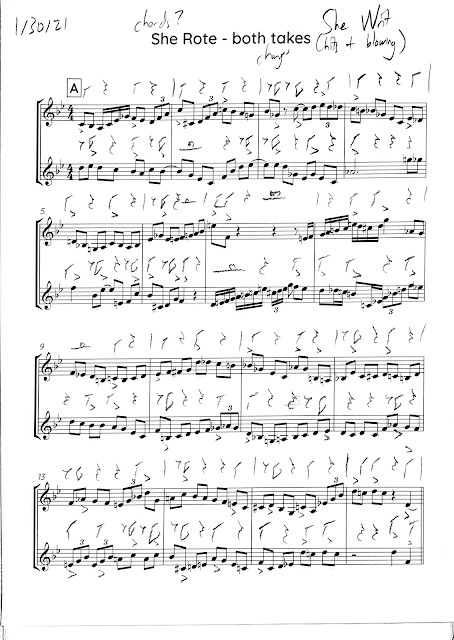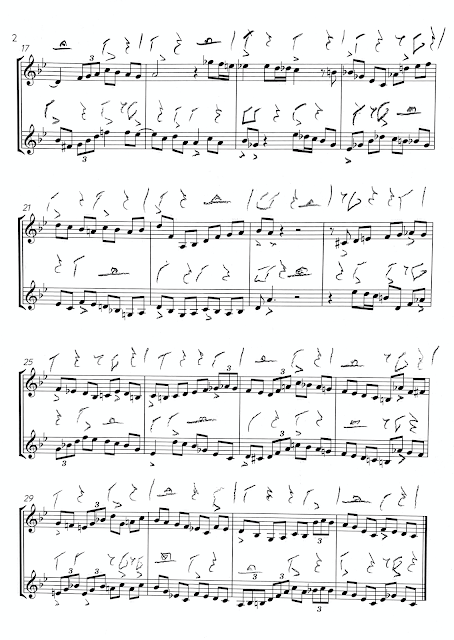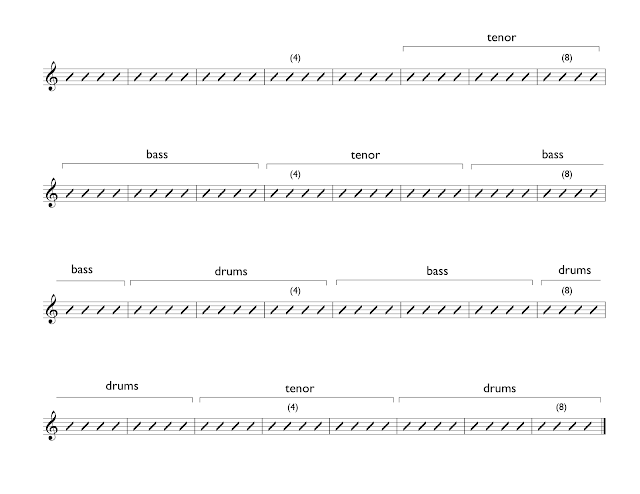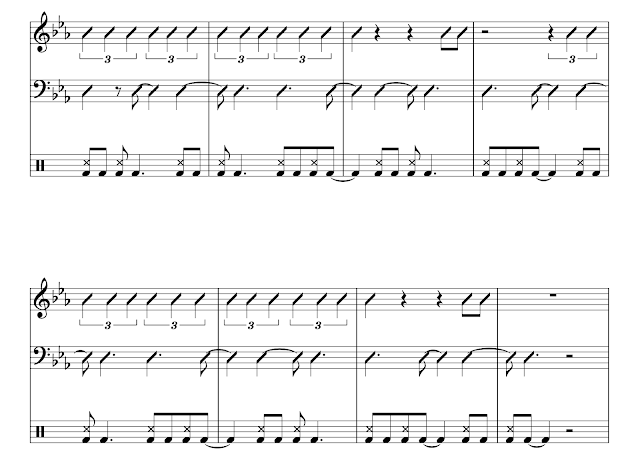Technical Notes on ♥️ Bird, III
More notes on the compositions that appear on <3 BIRD (see part 1 here and part 2 here).
7. Cheroot
Cheroot features the trio in extended dialogue over an accent map drawn from “She Rote.” [this and later introductory statements are mine from the liner notes]
What is an "accent map?" It's my fancy way of describing an extracted sequence of accents taken from an existing phrase (see notes to "Adroitness, Part II"). As part of my dive into "Synchronic Bird," I also tried overlaying two takes of "She Rote," with the accents of the combined line forming the basis for "Cheroot." As a note, I composed this specifically for The Jazz Gallery's Lockdown Sessions, Vol. 33 back in February 2021, and the "She Rote" portion can be heard here.
Below is my drawing of the accent map by looking at the two solos in conjunction and identifying the accents that I wanted to extract for the new melody:
Using the above as a starting point, I then create a composite rhythmic melody using some combination of the accents between the two lines:
I then assign pitches to the rhythms by selecting from the pitches in the "She Rote" solos that happen in the same place as the rhythms. Finally, I do another pass of this process to create a second chorus with slight variations in rhythms and a more or less new melodic line, and those two choruses form the melody of "Cheroot."
To add an element of chance and instability, I played with the idea of "trading" phrases, but rather than trading in groups of 4 or 8 measures, I specified irregular measure lengths and also specified the sequence of trading to certain instruments. This way, the melody of "Cheroot" is always being played by at least two of the three members of the band, but that third member gets to blow for a short period of time before returning to their spot in the form.
Below is the trading sequence for the first chorus:
The trading becomes more frequent during the second chorus, beginning with trades of 2 bars before moving to single bar trades:
8. Du Yi's Choir
Du Yi’s Choir reimagines “Dewey Square” through the lens of the mysterious introduction from the studio master take.
I believe it was through Ethan Iverson's blog that I first paid attention to the stunning introduction on "Dewey Square," in which the piano plays quarter note triplets while the bass and drums are playing a hemiola of dotted quarter rhythms below. It only lasts for eight bars, but it seems to crack open a window into another musical world for those brief moments:
Long before I had any intention of writing or recording the music that became <3 Bird, I started with this cross-rhythm idea and tried to extend it across the AABA form of "Dewey's Square" (fun fact: this was the first Bird-related thing I worked on, right before the pandemic lockdown in March 2020). I tried a bunch of different combinations of cross-rhythms of varying speeds, but I found that there tended to be a sweet spot where the two rhythms were relatively close to create rhythmic tension, but also not too fast or too slow as to sound either rushed or insufficiently "tense," respectively.
For "Du Yi's Choir," I ended up settling on the following sequence (first 4 bars shown for reference)"
First A: quintuplet quarter notes (chords) + quarter note tied to dotted eighth (bass, 7/16)
Second A: dotted eighth notes (chords) + triplet half notes (bass)
Bridge: triplet quarter notes (chords) + dotted quarter notes (bass), i.e. the "Dewey Square" intro ratio
Last A: quintuplet quarter notes (chords, same as first A) + quarter note tied to one sixteenth (bass, 5/16)
Following this scheme, the first A feels slowest, the second A a bit quicker, the bridge even quicker and more open (Walter/Matt played this section as the release by swinging in a kind of fast "3" feel, although it is in 4/4), and the last A is the most tense since the chord and bass note lengths are very close and rather quick.
This rhythmic tension final resolves in the coda, where chords and bass end by playing quarter notes together to reach the final tonic. As a note on the melody, I originally played the complete "Dewey Square" melody on the A sections, but felt that the sonic space was too cluttered with both the underlying rhythmic crosscurrent and the melody line, so I began omitting notes from the melody and replacing parts with sustain until I reached the skeletal melodic outline that is heard on "Du Yi's Choir."
9. Big Foot
Big Foot (or “Drifting on a Reed,” “Air Conditioner,” or “Giant Swing”) is a classic Parker blues revisited with a new groove.
"Big Foot" is one of Bird's 12-bar blues lines that I play most frequently. It's catchy, has a satisfying combination of upbeat/downbeat variations, and has a neat ending that loops back to the top. For this arrangement, I just wanted to see if it could be translated to a different meter without entirely losing the character of the original.
On the first melody statement, "Big Foot" is heard in a slightly elongated form in 5/4, with the piano playing chords in gradually quickening subdivisions: the chords initially are held for five eighth notes, then four eighth notes, then three eighth notes, cycling downward to triplet eighth notes at their quickest.
On a somewhat entirely unrelated note, I added a continually ascending bass line that occasionally drops an octave or two to stay within a reasonable range of the bass and piano. A harmonized version of the bass line serves as an interlude to the blowing section, which is in 9/8. Each bar, then, is a bit shorter than the earlier 5/4 melody statement, but the phrasing bar to bar varies: every bar has three quarters and a dotted quarter, but the placement of the dotted quarter moves around throughout the chorus. The last four bars are spelled out as a larger "9" (9/4, essentially).












Comments
Post a Comment